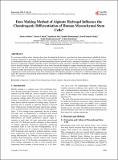| dc.contributor.author | Schiavi, Jessica | |
| dc.contributor.author | Charif, Naceur | |
| dc.contributor.author | de Isla, Natalia | |
| dc.contributor.author | Bensoussan, Danièle | |
| dc.contributor.author | Stoltz, Jean‐François | |
| dc.contributor.author | Benkirane‐Jessel, Nadia | |
| dc.contributor.author | Huselstein, Céline | |
| dc.date.accessioned | 2019-10-10T14:21:54Z | |
| dc.date.available | 2019-10-10T14:21:54Z | |
| dc.date.issued | 2012-10 | |
| dc.identifier.citation | Schiavi, Jessica, Charif, Naceur, de Isla, Natalia, Bensoussan, Danièle, Stoltz, Jean‐François, Benkirane‐Jessel, Nadia, & Huselstein, Céline. (2012). Does Making Method of Alginate Hydrogel Influence the Chondrogenic Differentiation of Human Mesenchymal Stem Cells? Engineering Geology, 4(10B), 110-113. doi: 10.4236/eng.2012.410B028 | en_IE |
| dc.identifier.issn | 1947-3931 | |
| dc.identifier.uri | http://hdl.handle.net/10379/15505 | |
| dc.description.abstract | To overcome cartilage injury, strategies have been developed in the last few years based on tissue engineering to rebuild the defects. Cartilage engineering is principally based on three main biological factors: cells (native cells (chondrocytes) or a more primitive ones as mesenchymal stem cells), scaffolds and functionalization factors (growth factors, mechanical stimulation and/or hypoxia). Cartilage tissue engineering strategies generally result in homogeneous tissue structures with little resemblance to native zonal organization of articular cartilage. The main objective of our work concerns the buildup of complex biomaterials aimed at reconstructing biological tissue with three dimensional cells construction for mimicking cartilage architecture. Our strategy is based on structures formation by simple and progressive spraying of mixed alginate hydrogel and human mesenchymal stem cells (hMSC). In this work, the comportment of cells and more precisely their chondrogenic differentiation potential is compared to a traditional making process: the mold. We report here that spraying method allowed to product a scaffold with hMSC that confer a favorable environment for neocartilage construction. | en_IE |
| dc.description.sponsorship | This work was supported by the "Lorraine region" grant. N.
Jessel is indebted to CHU de Nancy, Hôpital Central, orthopedic surgery (Contrat d’interface INSERM-CHU). | en_IE |
| dc.format | application/pdf | en_IE |
| dc.language.iso | en | en_IE |
| dc.publisher | Scientific Research Publishing | en_IE |
| dc.relation.ispartof | engineering | en |
| dc.rights | Attribution-NonCommercial-NoDerivs 3.0 Ireland | |
| dc.rights.uri | https://creativecommons.org/licenses/by-nc-nd/3.0/ie/ | |
| dc.subject | Cartilage Tissue Engineering; Sodium Alginate; Sprayed method; Molded Method | en_IE |
| dc.subject | Cartilage Tissue Engineering | en_IE |
| dc.subject | Sodium Alginate | en_IE |
| dc.subject | Sprayed method | en_IE |
| dc.subject | Molded Method | en_IE |
| dc.title | Does making method of alginate hydrogel influence the chondrogenic differentiation of human mesenchymal stem cells? | en_IE |
| dc.type | Article | en_IE |
| dc.date.updated | 2019-10-07T09:53:46Z | |
| dc.identifier.doi | 10.4236/eng.2012.410B028 | |
| dc.local.publishedsource | https://dx.doi.org/10.4236/eng.2012.410B028 | en_IE |
| dc.description.peer-reviewed | Not peer reviewed | |
| dc.internal.rssid | 13919331 | |
| dc.local.contact | Jessica Schiavi, -. - Email: jessica.schiavi@nuigalway.ie | |
| dc.local.copyrightchecked | Yes | |
| dc.local.version | PUBLISHED | |
| nui.item.downloads | 220 | |


